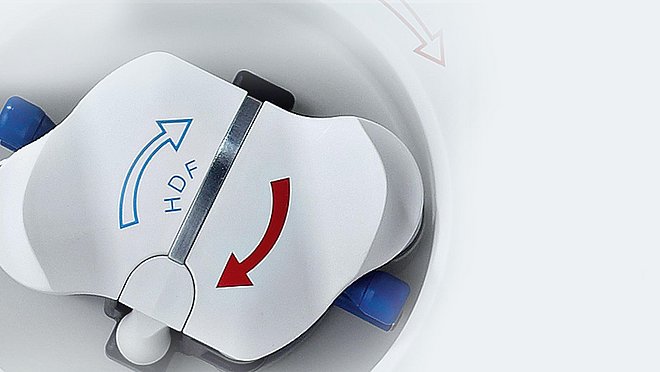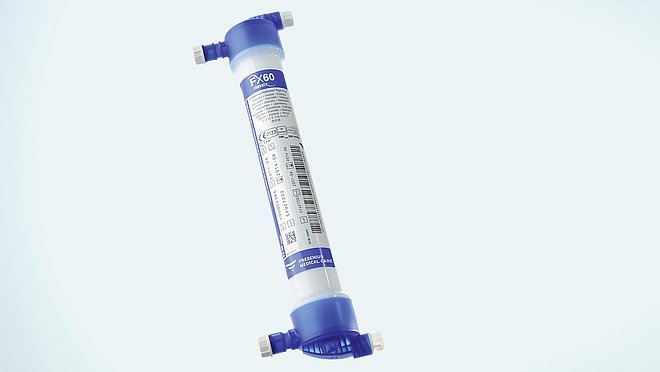Fluid management for hemodialysis

Effective cardioprotection
- Reduced mortality1
- Reduction of intradialytic hypotensive episodes2
- Cost-saving potential
Advanced fluid management for effective cardioprotection
The BCM - Body Composition Monitor was specifically designed to determine the amount of fluid overload that arises in patients suffering from renal failure. As a result, the BCM - Body Composition Monitor may help the clinician to determine a patient’s individual dry weight more accurately and, as a result, to remove the correct amount of fluid.
The BCM-Body Composition Monitor is the core component of Fresnenius Medical Care's Advanced Fluid Management therapy programme. It measures and quantifies the patient’s fluid status and provides a reliable decision basis for effective fluid and nutritional management. The BCM-Body Composition Monitor is a basic part of the CorDiax product line.
Cost-saving potential of fluid management
In dialysis patients, fluid overload is associated with acute complications, including congestive heart failure and pulmonary oedema. Fluid overload can require emergency dialysis outside of the routine dialysis sessions. These additional treatments are common and expensive.
BCM-Body Composition Monitor
From technology to therapy
Body weight and BMI (Body Mass Index) do not differentiate between muscle, fat and water. In addition, body composition is often described in terms of Fat Free Mass (FFM) and fat mass (fat) only, not considering overhydration.
The BCM–Body Composition Monitor is the first device on the market to distinguish the muscle mass from pathologic fluid overload. The BCM-Body Composition Monitor separates excess fluid (overhydration) from the lean and adipose tissue components of the body on the basis of a unique body composition model.
The BCM-Body Composition Monitor separates excess fluid (overhydration) from the lean and adipose tissue components of the body on the basis of a unique body composition model.
BCM—Body Composition Monitor

Quantifying fluid status for more confidence in fluid management The Body Composition Monitor is the first device on the market to distinguish muscle mass from pathologic fluid overload.
The three compartments

Body weight = Lean Tissue Mass (LTM) + Adipose Tissue Mass (ATM) + Overhydration (OH) The three compartments (LTM, ATM and OH) are identified from measurements of body weight, height, Intracellular Water (ICW) and Extracellular Water (ECW), determined by whole body Bioimpedance Spectroscopy (BIS).
Guiding the haemodialysis patient on the safe path between volume overload and dehydration can be difficult in daily clinical practice.
- Assessment of fluid status based on subjective indicators has been a limiting factor
- Several other methods that have been proposed are often unavailable, expensive or difficult to handle
- Most importantly, they are unable to quantify fluid overload or deficiency
The BCM-Body Composition Monitor is the only body composition device specifically designed for the use in patients with ESRD and is the cornerstone of Fresenius Medical Care's Advanced Fluid Management therapy programme. It measures and quantifies key fluid and nutritional parameters and provides a reliable decision basis for fluid and nutritional management of dialysis patients.
The BCM-Body Composition Monitor measures non-invasively and quickly at the bedside.
If you would like to order this product via the NHS Supply Chain Catalogue, please visit the following link: NHS Supply Chain Online Catalogue
Additional information relating to multiBic or Calrecia can be found in the critical care section of our product information page.
Adverse Events Reporting
Adverse events should be reported. Reporting forms and information can be found at
https://yellowcard.mhra.gov.uk/ or search for MHRA Yellowcard in the Google Play or Apple app store. Adverse events should also be reported to Fresenius Medical Care on 01623 445100.
UK/HEMA/FME/0922/0005 Date of Preparation: November 2022
1 Wizemann V. et al., Nephrology Dialysis Transplantation (2009); 24: 1574-1579.
2 Machek P. et al., Nephrology Dialysis Transplantation (2010); 25: 538-544.
3 Arneson T. et al., Clinical Journal of the American Society of Nephrology (2010); 5: 1054-1063.
4 Arneson T. et al., Clinical Journal of the American Society of Nephrology (2010); 5: 1054-1063.

